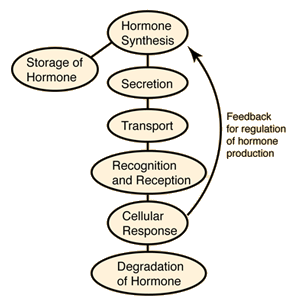Hormones
The term hormone refers to the specific chemical messengers or "signaling molecules" secreted by glands in the endocrine system. Most familiar are the "endocrine hormones" which are released directly into the bloodstream to be carried to the cells which have protein receptors which can respond to them. There are also "exocrine hormones" which are released into a duct. These exocrine hormones may then enter the bloodstream or be conducted from cell to cell by diffusion (paracrine signaling). By these means, hormones are carried to essentially every part of the body and serve various regulatory functions.
 | While the hormonal communication system is too complex to be summarized by a simple model, there are some common overall features. Typically, the glands of the endocrine system have specialized hormone cells. The hormone molecules are synthesized in these cells and exit the cells (exocytosis) via some membrane transport mechanism. When they reach a cell which is sensitive to that hormone, it will have a receptor for the hormone. The receptor will typically be in the cell membrane. The cellular response may be a cascade of reactions to accomplish the purpose of the hormone. There are often feedback mechanisms that serve to regulate the production of the hormone in the gland of origin. |
| Thyroid stimulating hormone (TSH) | Pituitary Gland | Stimulates the Thyroid Gland to release its hormones. |
| Thyroxine | Thyroid | Increases metabolic rate and stimulates synthesis of enzymes. |
| Antidiuretic hormone (ADH) | Pituitary Gland | Increases the permeability of the tubules in the nephrons of the kidney to release more water back into the bloodstream. |
References:
Wiki Hormones
| This material is part of a brief overview of the topics studied in biology with the intent to highlight the connections to basic ideas in physics and physical science. |
Reference
Audesirk & Audesirk
Ch 32
Thibodeau & Patton
Ch 16
| HyperPhysics***** Biology | R Nave |